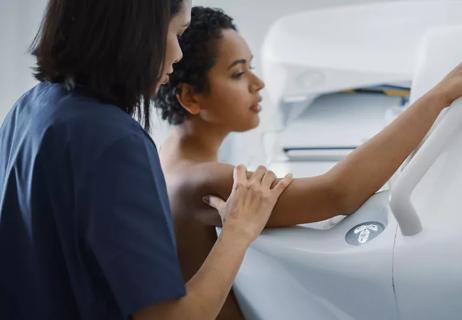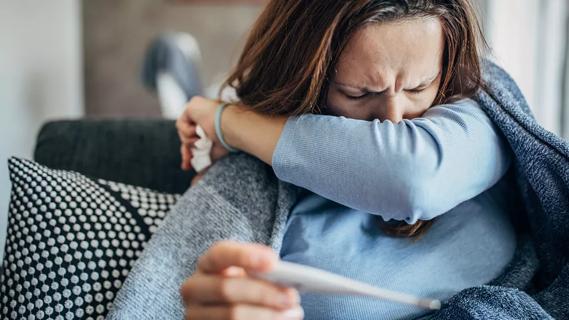And find out why it's not a good idea to skip one

#PandemicLife has made us rethink our approach to many daily activities. It might have also caused some of us to avoid seeing healthcare providers for routine checkups and exams. But despite the uncertainty that is swirling all around us, one thing remains quite clear — the pandemic shouldn’t stop us from making our health a priority. That’s especially true if you’re due for a mammogram.
Advertisement
Cleveland Clinic is a non-profit academic medical center. Advertising on our site helps support our mission. We do not endorse non-Cleveland Clinic products or services. Policy
The American Cancer Society estimates that this year:
Early detection has been key to helping to reduce the number of deaths related to breast cancer. That’s why mammograms are so important. If you’re thinking about skipping yours because of COVID-19, diagnostic radiology specialist Laura Dean, MD, explains why it’s not a good idea to do so.
Dr. Dean has heard a variety of reasons why patients don’t believe that they need mammograms.
“One common misconception that I hear is ‘No one in my family has ever had breast cancer, so I’m really not that worried about getting it.’ But the fact is the majority (about 85%) of cancers we see occur in patients who have no family history. Therefore, if we only screen patients who are considered high risk, we would be potentially missing a majority of breast cancers in the population,” explains Dr. Dean.
Another misconception — not experiencing symptoms or feeling lumps means nothing is wrong.
“I hear patients say ‘I don’t feel anything or have any problems with my breasts.’ The purpose of a mammogram is to identify cancers before they reach a size where they can be felt. When cancers are found early, we have better chances of treating them and the treatment/surgery may potentially be less invasive,” says Dr. Dean. According to Dr. Dean, studies have also shown that most lives are saved because of screening when mammography is performed every year beginning at the age of 40.
Advertisement
As for the whys, they’ve either been rooted in uncertainty or apprehension. And with a lot of non-essential medical services and procedures being canceled, some might have been under the impression that they couldn’t get mammograms.
Dr. Dean emphasizes that it’s very safe to get a mammogram right now.
“Many changes have been made in our workspaces to facilitate physical distancing. This includes spacing out appointment times to limit crowding in waiting rooms, separation of seating in waiting rooms, increased cleaning and sanitizing practices, health and temperature screenings for every patient and employee and of course, universal masking.”
While studies have shown that most lives are saved when mammography is performed every year starting at the age of 40, Dr. Dean says there still has been some controversy around when women should really begin getting mammograms and how frequently screenings should occur.
“For this reason, we encourage patients to talk to their healthcare providers. They can perform a risk assessment and determine the most appropriate screening regimen for each patient.”
Dr. Dean adds that women who are shown to be at a higher-than-average risk for breast cancer may even qualify for earlier, more frequent or more intensive screenings.
If you’ve never had a mammogram, it’s understandable if you’re anxious about getting one. But Dr. Dean says there’s no need to worry. Providers are aware that mammograms can be very stressful and they’re doing whatever they can to make the process easier.
“We understand that women have a lot of anxiety about getting a mammogram. Some women are concerned about discomfort during the exam. I always let them know that we are here to work with them and make the exam as comfortable and easy as possible. Women are also worried about having a false positive test. To address the question of false positives, the majority of patients who are recalled from screening are able to be cleared with additional imaging, even if a biopsy is ultimately performed. We always err on the side of caution and are very careful to take a closer look at anything that we question on the mammogram. However, many of these cases ultimately are normal.”
Wondering what you can expect during a mammogram? If you have questions, ask your provider. Dr. Dean says there are also many resources available about mammograms and the myths that are often associated with them.
“I refer my patients to the Society of Breast Imaging and Susan G Komen as references if there are persistent questions about screening, what to expect during the exam, results and more. I also remind women that the whole goal of screening is early detection. While we never hope to find cancer in anyone, the goal is to find cancers as early as we possibly can — while they’re small and easier to take care of.”
It’s recently been discovered that Pfizer’s and Moderna’s COVID-19 vaccines can cause lymph nodes in the armpit to swell, especially on the side where the shot was administered. This swelling has been mistaken as breast lumps by many, but they’re most likely the result of the body producing antibodies in response to the vaccine as it should.
Advertisement
To prevent any potential issues, the Society of Breast Imaging recommends scheduling mammograms before getting your first dose of the vaccine or four to six weeks after getting your second dose. This is suggested as long as it won’t interfere with routine care.
Advertisement
Learn more about our editorial process.
Advertisement

Annual screenings should start at 40 for most — but some people should start younger

The short answer: It’s complicated, but the basic care precautions still prevail, like washing your hands and isolating if you’re sick

They can feel like a typical headache or a migraine headache, but the pain can last for weeks to months

Any large social gathering — from a family birthday party to an indoor music concert — has the potential to spread serious infection

It’s important to connect with a healthcare provider, get quality sleep and balance your activities with your energy levels

Symptoms can overlap and be hard to distinguish, but there are some telltale differences

Just like the flu, COVID-19 will continue to evolve every year

It’s best to treat flu-like symptoms as if you have COVID-19

Type 2 diabetes isn’t inevitable with these dietary changes

Applying a hot or cold compress can help with pain